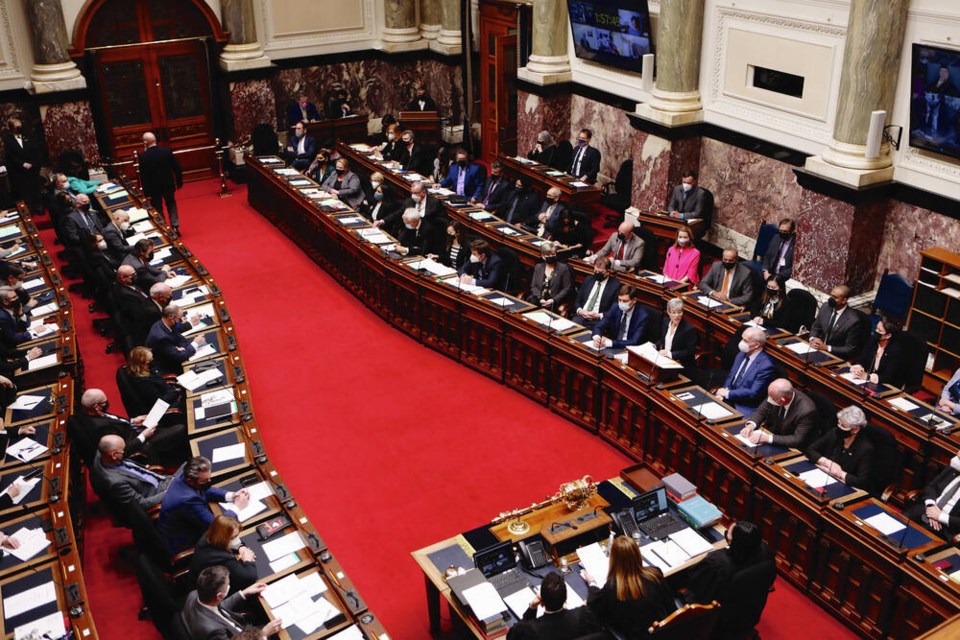B.C. officials are bracing for bad weather on a scale that up until last year was hard to imagine.
Tuesday’s budget earmarks serious new money for programs aimed at coping with weather-induced natural disasters of the sort that ravaged parts of B.C. in the past year.
Even while experts over the years have predicted with certainty that climate change is going to drive disasters, there was a feeling it was building gradually. Planning how to cope with them was a priority, but not a pressing one. Then the heat dome, wildfires and floods all hit in a period of months.
The hundreds of lives lost to heat and the multibillion-dollar losses incurred through winter flooding are now driving a race to prepare for what’s next, even while addressing last year’s losses.
The budget figures show it’s one of the biggest single-year priority adjustments ever made (apart from the pandemic). One line item illustrates how big. Every year the government makes an appropriation for the Emergency Program Act. Last year it was $36 million for operational support for disaster response and recovery.
This year it’s $436 million, 12 times as much, some of it allocated to cover damage already sustained.
That’s part of a new, multibillion-dollar commitment over three years on emergency management and recovery. A big chunk is for general contingencies over three years “in anticipation of investments that will need to be made to help communities recover.”
As a measure of how expensive recovery can get, the budget states B.C. has allocated $27 million on the fire-ravaged village of Lytton to date. But it’s still a barren townsite, almost devoid of people and the NDP is being criticized for its slow response.
That money is part of the big outlay on disasters in the current budget year. Most of it was due to just two days of heavy rain that drove 20,000 people from their homes. Bills are still coming in and the budget documents state: “The total cost and necessary supports are not yet known as work to evaluate the damage is ongoing.”
Another $5 billion in federal aid was already allocated for response and recovery to last year’s extreme weather.
There will be hiring sprees at two agencies to bulk up capabilities. In addition to the $400 million hike in the allocation for direct response, Emergency Management B.C. is also getting a big hike in its ongoing operating budget. So is the B.C. Wildfire Service, so it can move to year-round operations. The current model was described as being reactive to events. The new plan will see it converting to a year-round proactive approach with more emphasis on prevention and mitigation.
The fire service will also get millions more in its capital budget for equipment and new bases.
Separate from emergency disaster response, more money is earmarked for climate change preparedness and adaptation. A formal plan to that effect was only completed last June, and is still only in draft form.
The budget directs money for a range of monitoring systems on rivers and shorelines and adaptation strategies for both flooding and heat waves. The river forecasting centre will be expanded.
A new extreme heat response framework is called for that will better predict where and when heat waves will hit, and how the most vulnerable can be helped.
A community emergency preparedness fund that municipalities draw from will get $120 million provided this year. It will fund local operation centres and map flood plains and support risk assessments.
It looks like a series of hellish weather events drove a lot of the discretionary spending in the budget into one sector — disaster management.
Just So You Know: While all the focus Tuesday was on what’s in store for the fiscal year starting April 1, a report on the current year suggests good news ahead. The latest update on the books continues the pattern of grossly-overestimated deficit projections that shrink over the course of the year. Robinson estimated $9.7 billion worth of red ink last year. That was reduced to $4.8 billion, then $1.7 billion. Tuesday it was estimated at just $483 million.
Based on that performance, the $5.4-billion deficit projected for next year could disappear completely by the time the books close.
lleyne@timescolonist.com




